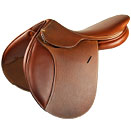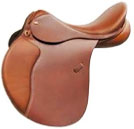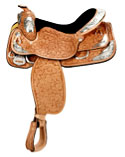Fitting The Saddle by Jude Bauer
Fitting the Saddle to the Horse:
The fit of a saddle affects the way you ride and the way your horse performs. There are many key points to consider when fitting a saddle to a rider and a horse. The first point is the saddle position. Make sure your horse is standing squarely on level ground b efore you begin. Next place the saddle on the horse's back, slightly forward on the withers. With your left hand on the horse's neck, just in front of the withers grab the saddle by the pommel with your right hand and give it a sharp tug back and down. The saddle "locks in" when it is in the correct position. Repeat the process; the saddle stops in the same place each time, allowing enough clearance for the horses shoulder to move freely.
efore you begin. Next place the saddle on the horse's back, slightly forward on the withers. With your left hand on the horse's neck, just in front of the withers grab the saddle by the pommel with your right hand and give it a sharp tug back and down. The saddle "locks in" when it is in the correct position. Repeat the process; the saddle stops in the same place each time, allowing enough clearance for the horses shoulder to move freely.
The next point is a level seat. Once you have your saddle in the correct position look at the lowest point of the seat, which, in most cases, is centered between the pommel (the front of the saddle) and the cantle (the back of the saddle), is this area level? A seat that is not level may indicate a serious saddle-fit problem, or it may simply mean that the panels require adjustment. This is an important point because the ideal position allows a rider to sit comfortably and effectively deliver seat and leg aids without putting undo pressure on the horse's back.
The next step is to evaluate pommel clearance. Hold your hand perpendicular to the ground then to slide it into the space between the pommel and the horse's withers. As a very general rule, two and one half to three fingers should fit into the space without feeling cramped or pinched. Another key point is the saddle's width, and this is probably the most important aspect of evaluating a saddle's suitability for a particular horse. When the width of the tree is not correct for a horse, the saddle does not fit. With the saddle in place on the horse look and see if the tree is too wide, it will sit right on top of the withers, or too narrow, the saddle will pinch the horse at the bottom of the withers.
Next you will want to simulate having a rider sit in the saddle. Place one hand on the saddle and apply some pressure, while doing this run your other hand from front to back under the length of the panel, feeling for any pressure points or bridging, a gap where the saddle does not touch the horse. This is also the perfect time to check for "rocking," which concentrates the rider's weight on one or two small areas of the horse's back, often causing soreness. Place one hand on the pommel an d the other on the cantle. Alternately press down with one hand and then the other. If the saddle rotates excessively on the center of the panel like a seesaw, this could be caused by a wrong-sized tree or inappropriately shaped panels. At this point you’ll want to position yourself near the horse's hindquarters so you can look down the gullet, the open space between the panels, from the rear. Ideally, the gullet clears the entire length of the horse's spine and does not touch the connective tissue on either side. Remember to keep in mind that the weight-bearing surface of a saddle should be between the horse's wither area and the point where the last rib meets the spine, technically known as T18.
d the other on the cantle. Alternately press down with one hand and then the other. If the saddle rotates excessively on the center of the panel like a seesaw, this could be caused by a wrong-sized tree or inappropriately shaped panels. At this point you’ll want to position yourself near the horse's hindquarters so you can look down the gullet, the open space between the panels, from the rear. Ideally, the gullet clears the entire length of the horse's spine and does not touch the connective tissue on either side. Remember to keep in mind that the weight-bearing surface of a saddle should be between the horse's wither area and the point where the last rib meets the spine, technically known as T18.
Finally girth up the saddle and watch the horse move with it on. A horse that moves freely, without hesitation or signs of distress, probably is wearing a saddle that fits correctly. Most horses show a dramatic change in disposition and movement when an ill-fitting saddle is the source of pain.
Fitting the Saddle to the Rider:
Your riding discipline influences the type of saddle you’ll need, because the overall design of any saddle is intended to assist with your riding. After you’ve determined the type of saddle you need, consider these key points to determine appropriate saddle fit: hip to knee length, seat size, and flap length and shape. Hip to knee length determines where your knee and leg fit in accordance to t he angle and point of the flap. When you try out saddles, look to fit this part of your leg first. The rotation and size of the saddle flap should complement the angle of your leg. Your knee should hit at the top point of the flap with at least two fingers to spare. As a very general guideline, the flap will fall only about a third of the way down your calf. The goal in determining flap length is to avoid having the edge of the saddle flap interfere with the top of your tall boot or half chap.
he angle and point of the flap. When you try out saddles, look to fit this part of your leg first. The rotation and size of the saddle flap should complement the angle of your leg. Your knee should hit at the top point of the flap with at least two fingers to spare. As a very general guideline, the flap will fall only about a third of the way down your calf. The goal in determining flap length is to avoid having the edge of the saddle flap interfere with the top of your tall boot or half chap.
Seat size affects your comfort level, ability to move and your effectiveness in your riding. Ignore the seat size measurement of the saddle, and work with what actually fits your body. If you have long legs, you may need a larger seat size so your knees do not hang off the front of the saddle. Every manufacturer’s sizing will feel different between models of saddles. The ideal fit will be when you can fit between three to four fingers (or a hand’s width) behind your bottom and the tip of the cantle. If you feel confined in a deep seated saddle, then try the next seat size up, a slightly larger seat is better than too small.
Difference in Saddle Types
A close contact saddle is a catch-all term used to refer to a jumping saddle. Typically it will have a rounded, more forward flap and seat. These saddles accommodate a bent knee, shorter stirrup, and a rider in a half-seat or two-point position. This type of saddle is used for hunt seat events such as hunters and jumpers, equitation , and hunter under saddle.
, and hunter under saddle.
A dressage is deep seated and straight-flapped, and the cantle is higher than the pommel by virtue of its design, which takes into account the amount of sitting a dressage rider does. In these saddles, the rider sits vertically with a long leg. Both the stirrup and flap length are longer because the rider’s knee is not bent as much.

An all-purpose saddle or eventing saddle will have a deeper seat, and a forward, but longer flap to accommodate the rider in a galloping position and usually has a swept-back cantle to keep it from interfering with the rider getting back coming off a drop fence.
 A Western saddle just like English saddles, come in a wide variety of styles. There are saddles available for pleasure or trail, roping, reining etc. all of which have slightly different features (such as a more or less pronounced horn, different balance etc.) making them more suited to a particular activity. This is not to say that you cannot go for a trail ride in a roping saddle, just that some saddles are designed to be more practical for certain things. All Western saddles will have a contoured cantle, with fenders and stirrups to keep the rider secure and comfortable in the saddle. The most obvious feature is the horn which, contrary to many beginning riders' belief, is not for their benefit but is used by the rider when working cattle.
A Western saddle just like English saddles, come in a wide variety of styles. There are saddles available for pleasure or trail, roping, reining etc. all of which have slightly different features (such as a more or less pronounced horn, different balance etc.) making them more suited to a particular activity. This is not to say that you cannot go for a trail ride in a roping saddle, just that some saddles are designed to be more practical for certain things. All Western saddles will have a contoured cantle, with fenders and stirrups to keep the rider secure and comfortable in the saddle. The most obvious feature is the horn which, contrary to many beginning riders' belief, is not for their benefit but is used by the rider when working cattle.
For the Equestrian Lifestyle
Newsletter for Hall Saddlery
"I have been told that I'm too slow at training horses, and yes, I do take my time. When I first start young ones I sometimes don't canter for months. I like a good relaxed walk (sometimes 15-20 minutes), the trot has to be straight, forward, and with rhythm. To canter, the trot should be with contact or long rein - with no deviation from rhythm. I like to take my young horses to open shows to hang out or if their calm enough, we attend a class. The open shows are inexpensive: the Washington County Twightlight (Friday nights) costs $15/stall. So, before they go to the expensive ($100+) shows, they get the experience they need at less cost. The picture below shows three young horses in their first horseshow. The grey is Mojo (a T-bred off the track) ridden by Kelly Cesarz, the black "Bela" is a TALL lanky T-bred owned and ridden by Lori Moran, and last is my Princess Allie. All these babies made it through the class without problems. It was a great experience for them as they are moving on to their true callings: Mojo to Dressage, Bela to Hunters, and Princess to Hunt and Western." —Jude Bauer

Left to right - Lori riding Bela, Jude riding Princess Allie and Kelly riding Mojo
EDITORS NOTES: Jude is manager at Hall Saddlery in Sussex, coordinating both the shop and Equestrian events. She has two horses. Her skill level in horses.... lets just say incredibly bright. When I picked up a saddle they helped to fit the saddle (great flex tree) both to me and to the horse. They give back to the community sponsoring events.
Hall Saddlery is located at N69W25055 Indian Grass Ln., Sussex, WI 53089 (262) 820-1755
web site: http://www.hallsaddlery.info
Return to topics.